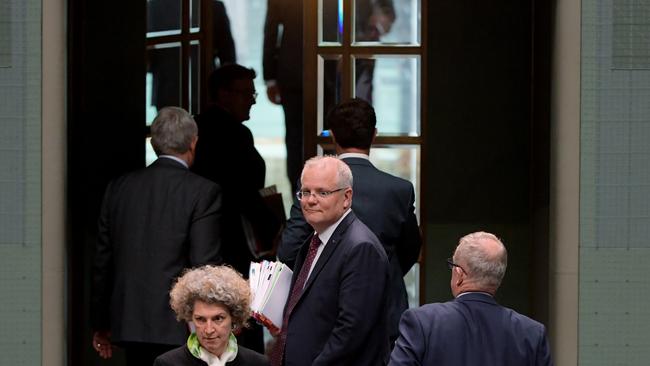ScoMo does a job on the banks with inquiry

The other half would say through gritted teeth: “ScoMo. It’s a ScoMo special.”
The evidence is circumstantial, but Scott “Profiteering” Morrison is widely seen to have abandoned the banks after voting against a royal commission 26 times — a record that the Labor Party will never allow him to forget.
Simply put, the banks reckon they’ve been erased from the list of industries in which the Prime Minister is prepared to invest political capital.
They believe the media was alerted first on Sunday to the competition watchdog’s inquiry, before Josh Frydenberg went about his courtesy calls to the major-bank chief executives later in the evening.
In Canberra, you can’t get much lower than that.
But the real reason they think the inquiry is a ScoMo special is that Frydenberg seems to have at least some understanding of the issues, which means there’s a gaping hole in his explanation for why it’s necessary.
For example, when the banks tried to justify their failure to pass on the Reserve Bank rate cuts in full, the Treasurer acknowledged they were right to highlight they had “many sources” of funding that were not linked to the cash rate.
Far and away the biggest bucket was deposits, accounting for almost 60 per cent of overall funding.
Also, when this column broke the story in mid-September that the ACCC had proposed a competition inquiry, the clear feedback — at least from sources outside the Prime Minister’s office — was that credit availability trumped everything, such was the level of concern about the flagging economy. This was consistent with the aggressive questioning of regulators by their oversight committees.
One senior banker was convinced on Monday that if word of the proposed ACCC inquiry had not leaked out, it would probably have never happened.
After the story did leak, it became self-fulfilling. And ripe for a ScoMo special.
Frydenberg opened up a gaping hole in the official rationale for the ACCC inquiry when he started reeling off a few interest rates without any meaningful context.
“Some of the banks advertise standard variable rates at 4.8 per cent but then pay a term depositor about 1.4 per cent and the cash rate is at a record low of 0.75 per cent, and it’s that gap we need to investigate and fully understand,” he said.
They’re nice numbers but totally meaningless by themselves.
The real issue is the impact of the RBA’s three recent rate cuts on the full range of bank funding costs, not the size of Frydenberg’s gap. And with the cash rate hurtling towards zero, the reckoning only gets more complicated, with any serious analysis showing there are about eight swing factors at play, of which only two are running in the banks’ favour.
Whatever Canberra might think, competition in the home loan market is strong, particularly for larger borrowers with sound repayment records.
Discounting is widespread, so the majority of existing customers are on package deals where the discount to the advertised rate is 100-150 basis points.
There’s also a change in the mix of lending, away from higher-margin, interest-only investor loans to owner-occupiers who pay principal and interest, and customers are far more active than before in re-negotiating more favourable terms.
Record-low interest rates take their toll on profit margins when the RBA again pulls the rate lever.
Commonwealth Bank, for example, has said it’s unable to pass through a full rate cut to $160bn of deposits, or one-third of its local deposit base.
Term-deposit margins are falling, and the return from banks investing their shareholders’ capital continues to decline.
The only two factors pulling in the right direction for the banks are the cost of domestic and wholesale debt, and an improvement in the spread of the 90-day bank bill rate over the cash rate.
Three of the four major banks — Westpac, ANZ and National Australia Bank — will report their full-year profits in the coming weeks and are expected to provide a clearer picture of the damage sustained by their deposit margins from the recent rate cuts.
Suffice it to say, their margins haven’t been inflating.
At the very least, the ACCC inquiry will intensify pressure on the industry to pass on more of any future rate cuts.
The bigger danger would be elimination of the so-called loyalty penalty, where existing customers don’t get the same discounts as new ones.
UBS has estimated the total hit to the major banks’ net profit would be $3.8bn.
Banks over the years have learned how to conduct a good scare campaign, and it kicked off in earnest on Monday with Westpac boss Brian Hartzer warning that the bank’s current level of profitability supported its AA credit rating and return on investment, which had already halved over the last 15 years.
To lose its credit rating, he said, would mean more expensive wholesale funding, and higher interest rates for borrowers.
gluyasr@theaustralian.com.auTwitter: @Gluyasr



Ask a roomful of bankers who’s to blame for the ACCC inquiry into home loan pricing and half would glumly respond: “Who cares?”